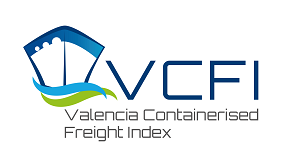
The VCFI index advances 1.83% in September and accumulates a growth rate of 7.79% since January 2018.
The withdrawal of ships for the installation of scrubbers reaches 2.8% of the fleet in circulation in September.
Valencia, October 4, 2019.- The Valencia Container Freight Index (VCFI) corresponding to the month of September experiences a growth of 1.83% compared to the previous month, standing at 1,077.94 points. It thus accumulates a growth rate since January 2018 of 7.79%. This change in trend with respect to the previous month evidences the volatility in the situation of export markets and their freight, since the same upward or downward trend has not been repeated since the beginning of the year for more than two consecutive months.
The growing movement in September also moves to the main geographical areas under study, with several general factors that can influence the behavior of export freight from Valenciaport.
One of these factors is the rise experienced by the price of a barrel of oil to reach $ 62.83, which represents a growth of 6.4% over the previous month. During the month of September, geopolitical tensions between the oil-producing countries have intensified, being on this occasion the attack on two refineries in Saudi Arabia the main trigger. Although at first the analysts anticipated a higher price increase, finally the rapid response of the Saudi producers led to the progressive recovery of production and its effect on the price of a barrel of oil.
Another relevant aspect is the strength of the dollar with respect to the euro; which influences the freight rates set in dollars, since the dollar is currently at maximum levels with respect to the euro, since the beginning of this index.
A more detailed analysis of the current currency market situation can be found in the section “under the microscope” in the Report of the Economic Environment of the Quarter, published as a complement to the VCFI.
In this work we can see how, on the supply side, an increase in the idle fleet is observed in September. From the middle of August to the beginning of September there was a fall in the idle fleet, going from representing 2.4% to 2.1% of the total active fleet. However, in the middle of September, the idle fleet suffered strong growth, from 476,136 TEU on September 2 to 641,249 TEU on September 16th, representing 2.8% of the fleet in circulation.
Part of this increase can be explained by the withdrawal of ships for their corresponding installation of scrubbers (cleaning filters of polluting particles) as happened the previous month, another important part is due to the strategy of blanked sails followed by the shipping companies, forced by the weak world trade demand, as pointed out from Alphaliner.
Data from the World Trade Organization (WTO), show how world goods has been reduced by 0.2% in the second quarter of the year compared to the same period of the previous year, thus accumulating a fall of 0 , 1% in the period January to June 2019. Thus, this strategy of the shipping companies to withdraw supply of capacity from the market may have also contributed to soften the fall in freight rates.4
Regarding freight behavior in the main commercial areas analyzed in the VCFI, highlight the growing price behavior in most of them: 11 of the 13 areas experience freight increases. The growth in freights with East Coast Africa stands out (6.25%), which continues with the upward trend initiated in the previous month. Also, those related to exports with the Eastern Mediterranean (2.58%), which represents a change with respect to the downward trend suffered in August. However, it is necessary to underline the volatility of freight rates with these two areas since the beginning of the year, which does not allow to conclude if this increase is something punctual due to circumstantial and commercial circumstantial factors or, if, on the contrary, it is due to structural factors and therefore will be maintained over the next few months. The same applies to freight rates with the Indian Subcontinent, where its growth breaks with the downward trend initiated in 2018 and it remains pending to determine whether this change is the beginning of a new growing trend. It also highlights the increase in the level of freight with the Middle East (4.80%), which continue with the upward trend initiated in July and coincides with the increase in export traffic from Valenciaport with these markets.
As for the remaining areas, while in Atlantic Europe, freight rates remain stable, Baltic countries are the only area where shipping prices are reduced, in line with the reduction of export traffic from Valenciaport with these markets.

